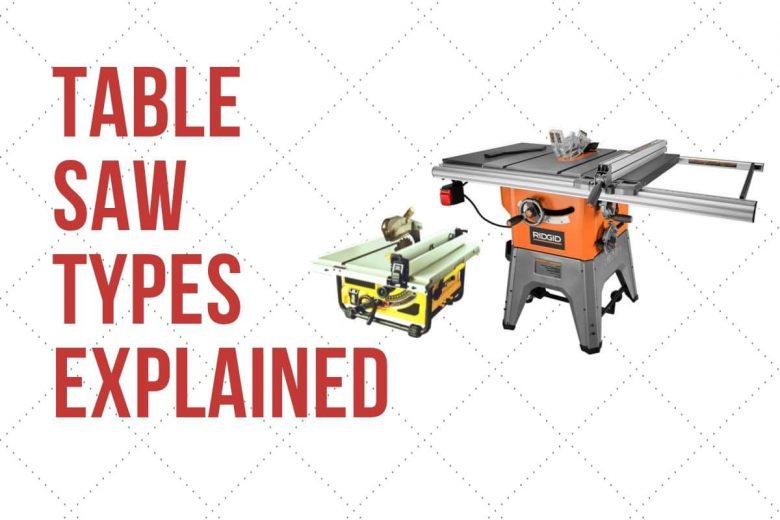As I began to upgrade the power tools in my workshop, I realized that the table saw needed to be one of the first things I should buy. The variety of cuts and the time saved would be really beneficial, but I felt overwhelmed by how many types of table saws were out there. I needed to learn what those differences were so that I could find the right table saw for my projects as well as my workshop.
Let’s take a closer look at five designs you will come across as you shop for a table saw so that you can make the most educated purchase possible.
Benchtop Table Saws
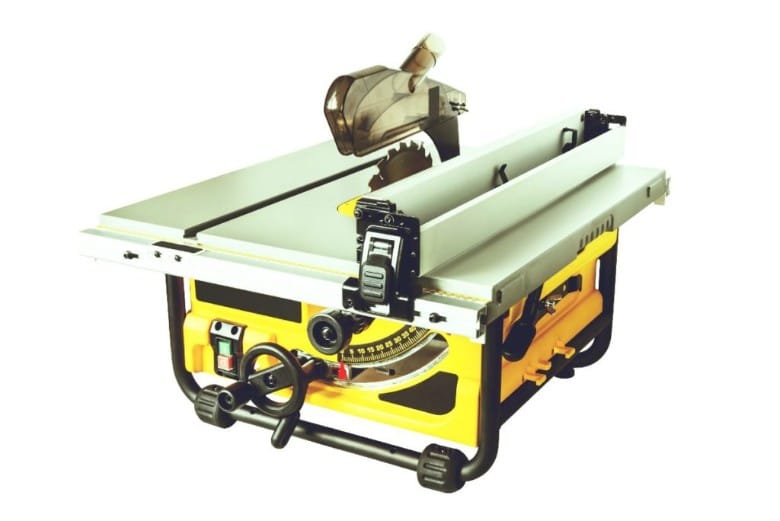
Most people are familiar with this type of power tool as it is seen at every big box store and online retail site. This is arguably the most common purchase in the table saw family due to features that nearly anyone can make use of.
One of the first things you need to note about this type of power saw design is its small size. Benchtop models are compact and lightweight when compared to other table saws, such as the contractor or cabinet designs. They can be mounted to a power tool workbench or to a table saw stand that usually can be purchased as an extra.
Workload size is limited by the motor and table fences, but most DIY homeowner projects and small or medium-sized woodworker items are manageable. These can be found in many sizes, but I would suggest sticking with a 10-inch blade table saw. Smaller table saw blades will struggle with many lumber sizes you will find yourself working with, while the larger 12-inch blades can only be found on industrial-grade cabinet table saws.
PROS
- Provides the most compact design overall, allowing it to be moved easily
- They usually come with simple controls that novices can grasp quickly
- These table saws are often found with a low price tag when compared to the other design types
CONS
- The benchtop designs will include motors that generate less power
- A woodworker may outgrow this style of a table saw as their hobby progresses
Who are benchtop table saws designed for?
While anyone could benefit from this type of power tool, it is best suited for amateur DIY projects around the house and weekend woodworkers. Most products in this line are budget-friendly, making them appealing to casual hobbyists as well as novices looking to build up their power tool collection without breaking the bank. Its compact design makes it easy to move and store, which can be a critical feature in a shop with limited space.
This type of product should prove easy to use, and you will find many accessories/blades at local stores as well as online.
Jobsite Table Saws
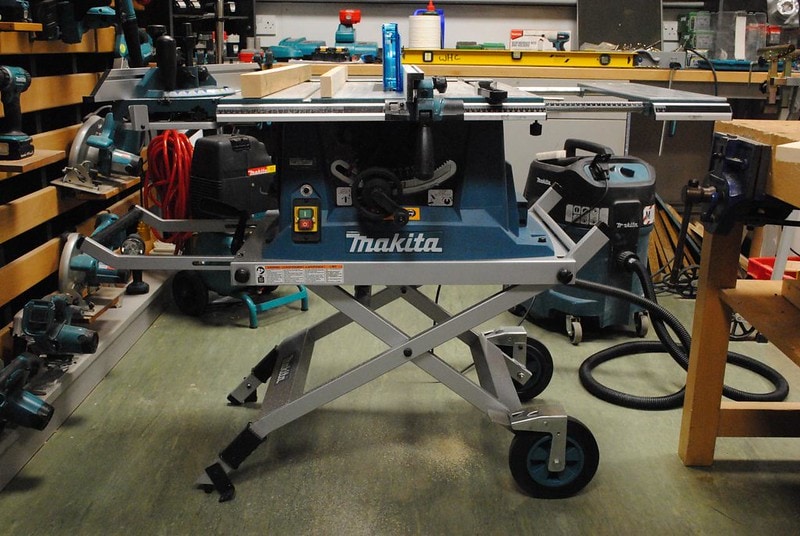
The job site design attempts to keep the mobility found in the benchtop models while upgrading the cutting power to handle heavier workloads found in more professional settings. You have probably seen many job site table saws sitting next to their smaller cousins at the store. While they may not be as lightweight as benchtop table saws, these saws still offer users a mobile table saw option.
The usual upgrade over benchtop units is found in the motor. A job site model will often boast of the highest amperage in a manufacturer’s product range. They will also include similar features that may be made from a more durable material, such as cast iron upgrades to components that are made from aluminum in benchtop products.
Extra design considerations with these table saws will include gears and motor parts that are upgraded for heavier use over longer periods of time. Job site table saws will include a table saw stand. It will be a sturdy design with legs terminating with cushioned soles, rollers, wheels, or a combination of these methods.
Fences and miter gauges on job site products are made to provide more accuracy than low-budgeted units, and they can include upgrades to the fence gears that allow for smaller adjustments to be made.
PROS
- A job site table saw will often come with a larger motor that can generate higher horse-power and blade RPMs.
- Almost all products of this type will come with a light table saw stand that can be set up in one spot or wheeled into position.
- While the left-sided cuts from the blade vary slightly, the cuts made to the right of the blade will have wider maximum fence depths than those found on some of the smaller benchtop products.
CONS
- These table saws will often sacrifice some build material quality to provide extra power on the motor or width on the fence for right-handed cuts.
- The table-saw stands included with many job site models are less durable in design elements like the scissor joints or with the wheels on most products.
Who are job site table saws designed for?
The target audience for these products is professional carpenters. These power tools are made to provide mobility between locations while offering more power than other mobile designs. They are accurate enough for most carpentry work but may lack the high-grade measurements or settings found on table saws designed for cabinet makers.
Read our guide on the best portable jobsite table saws to find out if this type of table saw is a good match for you.
Contractor Table Saws

You may have come across job site table saws that are called contractor table saws, but this category of products stands out in noticeable ways compared to the former. The size and weight of a contractor saw will clue you in from the start, as this style of power tool is designed to be placed in a dedicated location. Another clue may be the price, as the cost of these will often be higher than you will find benchtop or job site saws going for.
A contractor table saw will use heavy-duty materials in the construction of its components, making it highly durable. That includes cast iron and steel, as well as high-impact plastics for some control parts. These saws are also equipped with fences and gauges that provide highly accurate readings as well as micro-adjustments.
The motors on a contractor saw are powerful, and some units can run on either 110 or 220 volts. Those models equipped with the largest motors will require 220 volts from the start. Due to the higher voltage, some manufacturers will include extra safety and circuit protection on their contractor-grade table saws.
PROS
- You will usually get the most powerful motors available from the manufacturer on this type of table.
- Most tabletops and table wings used on a contractor saw are made from cast iron.
- It will include an upgraded table saw stand that will be more durable and stable than those used on job site table saws.
CONS
- This style of table saw is much heavier than the portable designs and will need a dedicated space it can sit at.
- The larger motors and belts on these types of saws can generate more vibration during the cut than smaller products will.
Who are contractor table saws designed for?
These products are ideal for serious woodworkers or contractors needing a stationary table saw at larger work sites. They are best suited for areas where they can be set up and left. This style of table saw will provide the power you will need with larger projects or the capability you will need if you use it throughout the day.
If you think that this is the right saw for your workshop, make sure to also read our guide on the best contractor table saws.
Cabinet Table Saws
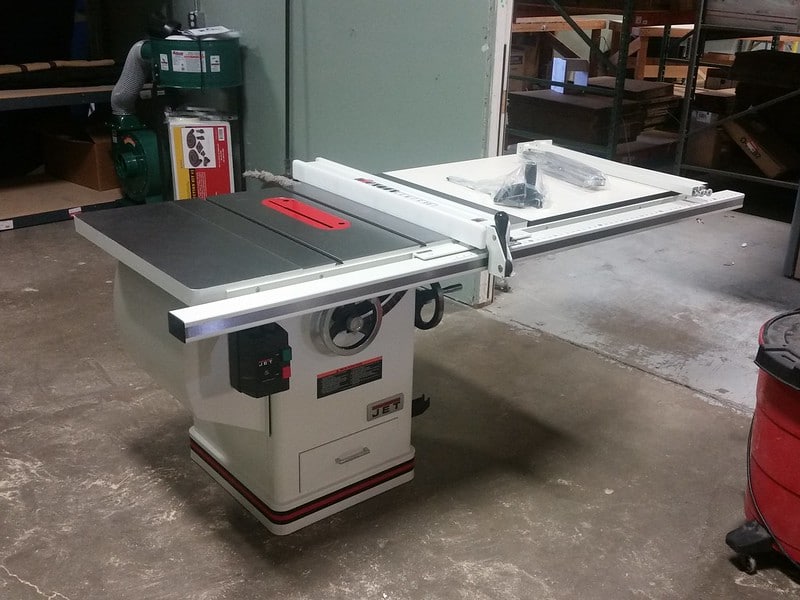
If you ever had a woodshop class in a school or a community center, then you probably had access to a cabinet-style table saw. They often have the largest footprint among this type of power tool, with a heavy cabinet built around the motor and gears that will require a dedicated space in your shop.
These table saws will make use of the largest motors available from most manufacturers, something that will require a dedicated 220-volt outlet. The better models will provide extra motor protection in the form of heat dissipation or advanced gear designs to transfer more power to the blade.
A nice feature on a majority of the cabinet saw designs is the housing that encourages the collection of debris that results from making cuts into the wood. This makes for a cleaner shop when coupled with a dust collection system. Housing may also help reduce the noise generated by the motor.
A cabinet table saw will provide you with some of the most sturdy housing you will find for a table saw. That helps to promote a truly flat work surface, especially with the heavy-duty materials the cabinet and table are made from. You will often find that these models will offer the most flexibility, as they have the space to provide blade and table adjustments.
PROS
- This style of table saw provides an enclosure for the motor as well as a space that can help collect debris for a dust collection system.
- A cabinet style saw will usually provide you with the most rigid platform to work from between the styles of table units.
- Manufacturers will usually load this type of power tool with the most end-user features that will be found in their product lines.
CONS
- These table saws come with a large price tag, making them an item found in commercial settings or in shops that are making large volumes of cuts, like cabinet-makers.
- This table saw design will require a dedicated space with enough room to house the saw as well as extra space for the wood being worked on.
Who are cabinet table saws designed for?
This high-end power tool will be found in commercial fabricating or in the shops of serious woodworkers. They are bulky and heavy, requiring a dedicated space to operate in. They will often provide the most accuracy and adjustability in the table saw range, making them great for all cabinetry projects.
Related: Best Cabinet Table Saws (2024 Review).
Hybrid Table Saws
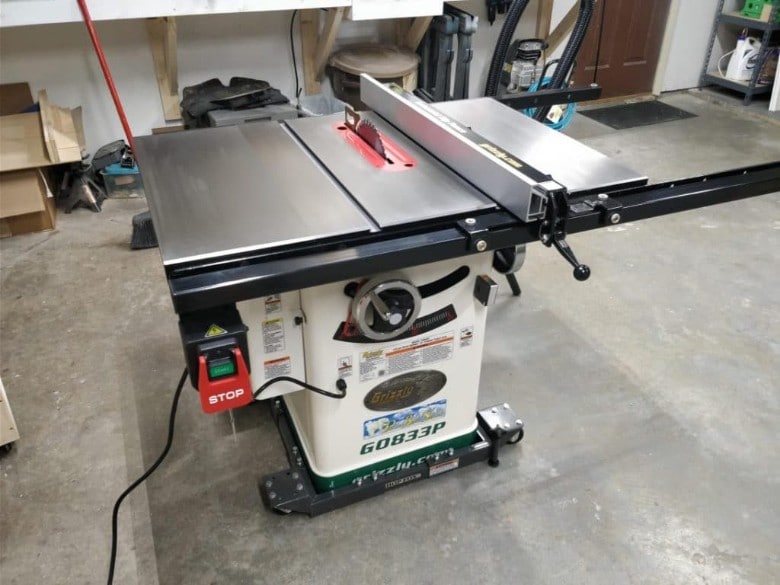
This is often considered a confusing category of a table saw, as customers and manufacturers alike use the term broadly. For our purposes here, I am referring to the higher-end table saws that combine many cabinet table saw features with a less bulky frame that cabinet designs are known for. Those changes allow the company to provide you with these types of saws at a smaller price point while offering most features they include in their cabinet styles.
Many hybrid saws use open legs, or stands, for table saw support. There are, however, a few models that may be fully enclosed. The power required for a hybrid may be either 110 or 220 volts, with the latter used more often. They will most likely use the highest-grade building materials to offer the most sturdy table saw and stand.
Many of the product lines found in this table saw range will include the wide array of features found on cabinet models, including extra accessories.
PROS
- You can often get the dust collection or motor power found in a cabinet model in this type of saw, often with a small price tag.
- There are hybrid models that have a similar size or weight of a contractor table saw, making them a little easier to place in your shop than a large cabinet saw would be.
- This style of table saw will offer a wide range of features, perhaps affording you a bit more options and giving you the ability to purchase a table saw that fits your needs more specifically.
CONS
- The benefits and features offered on a lot of hybrid table saw models are similar to contractor-styled products, making the additional price tag stand out more.
- Many hybrid table saw models are enclosed and will require the same amount of room needed for a cabinet table saw design.
Who are hybrid table saws designed for?
I feel that the hybrid design works well for serious hobbyists, as well as those woodworkers who are starting up a commercial woodworking business. The compromise between a cabinet and contractor table saw features will usually address most of these types of users’ needs. It will also cost less for the user who may still be under budget restrictions, which will not justify a full cabinet table saw purchase.
Read more about the best hybrid table saws.
Which Table Saw Should You Choose?
1. Consider your budget
Your selection will be limited by the amount of money that you have to spend. Most benchtop and job site products are reasonably priced. On the other hand, a full-sized cabinet saw will come with a large price tag.
2. Consider the space you will need
Space will be another consideration. If you have limited room in your shop or garage, a portable table saw will allow you to take advantage of the room you do have to make cuts. If you have space, upgrading to a more stationary design will let you make use of larger motors and perhaps more features.
3. Consider the size of projects that you make
Benchtop and job site table saws are great for cross and rip cuts on a variety of panels and boards. If you find yourself making lots of furniture with bigger panels, it may be necessary to go with a contractor or cabinet saw to make consistent cuts safely.
4. How much time do you spend in the shop?
Finally, a smaller saw design may be perfect for the DIY homeowner or casual woodworker. Larger table saws are usually needed by serious woodworkers or professionals.
Cutting Through It All
There are so many types of table saws out there that you should be able to find a match for your projects as well as your needs. If you are just starting out with woodworking, or if you are building up your power tool collection, I would suggest sticking with a benchtop or job site table saw.
Once you reach an intermediate level with your woodcraft, you may want to consider upgrading to a larger contractor or hybrid. For serious woodworking and commercial cabinetry, the full-sized cabinet table saw might be the way to go.
Your final selection should include your budget, the space you have to work with, the size of projects you usually work with, as well as how often you will be using your table saw. Read my extensive table saw buying guide to learn more about this tool and how to buy one for your workshop.
Related:

